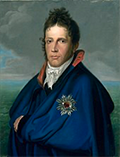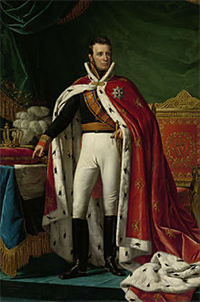King William I of the Netherlands
William I was the first King of the Netherlands, ruling for more than two decades in the first half of the 19th Century. He was born on Aug. 24, 1772, in Huis ten Bosch, The Hague. His father was William V, Prince of Orange, and his mother was Princess Wilhelmina of Prussia. Young William enjoyed the privileges of court, including learning the military arts and getting educational instruction from famed mathematician Leonhard Euler. William V proved an autocratic Stadtholder, angering many in the provinces who had enjoyed more autonomy under previous leaders. The disastrous results of the Fourth Anglo-Dutch War, in 1780, left the Dutch Republic destitute and the government in disarray. A short five years later, William fled the republic in the face of armed opposition. Intervention by a Prussian army ended the uprisings and restored order. Young William then attended the Brunswick military academy. After a brief stint of study at the University of Leiden, he won appointment as an infantry general in the States Army. He fought in a handful of battles in the War of the First Coalition, against France. At the end of 1794 and the beginning of 1795, a particularly harsh winter froze solid the rivers that had traditionally made the Netherlands immune from attack. A French army under General Charles Pichegru, assisted by Dutch troops under General Herman Willem Daendels, invaded and found victory as well as public support. The latter followed the former especially once a French fleet at Den Helder had achieved the seemingly impossible, capturing a Dutch fleet stranded by the ice. The Dutch Patriots grew in numbers and succeeded in taking over some of the state's population centers. William fled to England, leaving his country in the hands of the newly proclaimed Batavian Republic. 
The prince went with his father to Great Britain. Young William's stay was short, as he returned to the Continent and made several attempts to take back what his father had lost. He fought in the unsuccessful Anglo-Russian invasion of 1799, then joined Prussian forces in fighting against France. (His brother-in-law was the Prussian king, Frederick William III.) William commanded Prussian troops at the Battle of Jena-Auerstedt, won by France. William surrendered his army and served time as a prisoner of war. He had befriended French Emperor Napoleon Bonaparte earlier, and the emperor ended William's captivity after the latter promised not to fight anymore. In the meantime, Napoleon had appointed his brother Louis as leader of the newly created Kingdom of Holland. Reneging on that promise in 1809, William served as a major-general in the Austrian army at the Battle of Wagram, at which he sustained a leg injury. He took to living in exile in Prussia. The Allied powers won a convincing victory at the Battle of Leipzig in October 1813, and one of the results of that battle was France's relinquishing of the Orange-Nassau territories. William was around and ready, having lost his lands and titles to the French with the ascent of Louis Bonaparte. William VI became, in 1813, the Sovereign Prince of the United Netherlands and then, two years later, William I, King of the Netherlands. This was the birth of the modern country. 
In his first capacity as ruler, he had nearly absolute power. His ministers reported only to him, and the States-General had very limited ability to effect change. The following year, he added the title Grand Duke of Luxembourg, gaining rule of that tiny entity after executing a land swap with Prussia. Even though William had extensive powers, he had a title that didn't include the word king. He rectified that in 1815, proclaiming on March 16 that he was King William I, of the United Kingdom of the Netherlands. Other European powers ratified his proclamation at the Congress of Vienna. The States-General when William was Sovereign Prince was unicameral. The new kingdom declared a two-chamber body, whose prime responsibility was to approve the laws and decrees of the king. This new governmental blueprint proved popular in the north but not so much in the south. In an attempt to offset this, he declared that his inauguration would be in the southern city of Brussels. Among his new initiatives were the creation of a central bank and of a central trading society. By this time, even though the provinces had been reunited for some time, the differences between north and south were noticeable and, in some cases, stark. In the north, the people spoke Dutch, had mainly commercial jobs, and, for the most part, professed to Protestantism; in the south, they spoke Dutch but also French, had mainly industrial jobs, and practiced Catholicism. William issued a few decrees that angered those in the south, such as requirements for all students to use the Dutch language in schools and to study the teachings of the (Protestant) Dutch Reformed Church. He also nationalized some of the major universities. People in the south by 1830 had had enough. Speaking out against the king and his policies led to increasingly violent confrontations, and riots ensued. An angry William sent armed troops to quell the riots. This action was entirely unsuccessful. In fact, those doing the uprising maintained the upper hand and ultimately declared their independence. Out of the Belgian Revolution came a new state. In 1831, William struck back, sending an army featuring his sons William and Frederick to take back what had been lost. The Dutch proved successful during the Ten Days' Campaign but, after hearing that France determined to intervene on the side of the Belgians, retreated. Undeterred, William continued the war on a smaller scale for eight years. The result was economic uncertainty and public resentment. The 1839 Treaty of London ended the war, and William became the ruler of the Kingdom of the Netherlands. The new state came with a new constitution, one that William did not like. Frustrated by his lack of success and wary of losing power that he once wielded, he decided to give up his throne. He did so on Oct. 7, 1840. His oldest son became King William II. The former William I went to Berlin, where he died in 1843. He was 71. William had married Wilhelmina of Prussia in 1791. They had six children, four of whom survived into adulthood: William II (1792), William Frederick (1797), Pauline (1800), and Marianne (1810). Wilhelmina died in 1837; William married Henrietta d'Oultremont in 1841. |
|
Social Studies for Kids
copyright 2002–2026
David White




